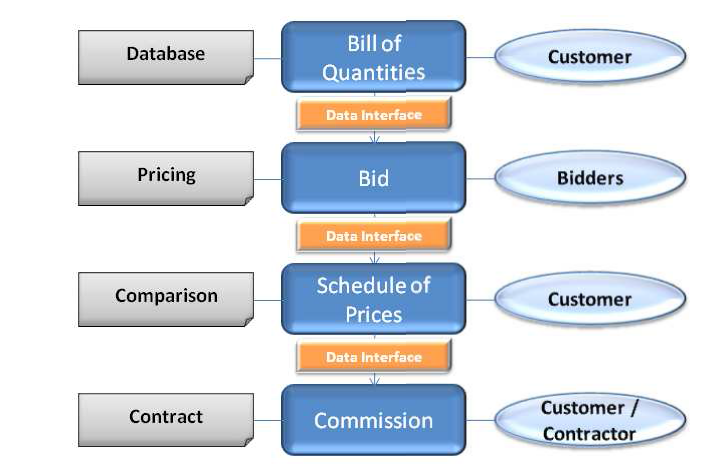Computers in construction tendering
Traditionally, invitations to tender, specifications, bills of quantities and other contract documents have been drawn up independently and exchanged in paper form. Today, collaborative and comprehensive software tools can support the complete process of tendering, communication is almost exclusively electronic and documents are exchanged on web sites, by email and on portable data storage devices, such as DVDs, CD-ROMs and memory cards.
The first comprehensive software tools that supported tendering procedures were introduced as early as the 1970s. Starting with punch card systems, the development of these tools led to new forms of data exchange. Since then, with the possibilities provided by the internet, spatial barriers have also been broken down. Computers can exchange tender information anywhere worldwide in real-time and digital signatures can ensure that the are binding.
Software tools support this process from the beginning with the preparation of the bill of quantities. Since databases will already store design information from a building model on the one hand, and predefined specifications on the other, quantities can be calculated and tender documents generated.
During the construction process new measurements can be filed and included, with the result that every item, as well as the total volume, is updated automatically.
Digitally transferring the bill of quantities in a structured form to the tenderers' calculation software saves time and money. On the basis of this information, the tenderer is able to calculate a price. Their tender is passed back to the client, again digitally, and all the tenders received can be compared electronically. As a result, a schedule of prices can be created by the client’s software allowing bids to be evaluated against a range of criteria. Before the contract is awarded, modifications resulting from tender negotiations or changes in conditions, contingency items, cancelled items or price changes can all be included in the final contract documents.
A digital version of the bill of quantities can also support the calculation and agreement of variations during the construction phase.
Websites have gained importance as a result of the electronic tendering (e-tender) process. There are several platforms which specialise in the tendering of private and public construction contracts. Similar to offline tools, these websites support the whole procurement process, starting with the download of an invitation to tender through to the legally binding acceptance of a tender. Public administrations and large-scale enterprises increasingly use e-tender platforms, to save cost and time (for example, the European “Tenders Electronic Daily” (TED)).
The main types of software used for the tendering process are listed below:
- Preparation of specifications and bills of quantities:
Software tools for the preparation of specifications and bills of quantities automatically relate measurement data to the corresponding specification texts according to a given item structure. The specifications are based on technical norms and can usually be inserted as standard text blocks.
- Costing and accounting:
Software tools for costing and accounting support cost estimation and analysis. These applications are used by tenderers as well as clients. Costs can be estimated and controlled on the basis of data from the bill of quantities.
- Comparative analysis of unit prices:
Software tools for the comparative analysis of unit prices are used by clients to choose between several tenderers. Predefined evaluation criteria highlight differences between tenders and support the decision-making process.
- Web-based e-tendering:
Web-based e-tendering supports the tendering process in various ways. Websites can supply data for tender inquiries and enable tender documents to be requested and dispatched. The scope varies greatly depending on the provider.
The text in this article is based on an extract from COMPUTER METHODS IN CONSTRUCTION, by Christoph Motzko, Florian Binder, Matthias Bergmann, Bogdan Zieliski, Mariusz Zabielski and Robert Gajewski. Darmstadt, Warsaw 2011. The original manual was developed within the scope of the LdV program, project number: 2009-1-PL1-LEO05-05016 entitled “Common Learning Outcomes for European Managers in Construction”. It is reproduced here in a slightly modified form with the kind permission of the Chartered Institute of Building.
--CIOB
[edit] Related articles on Designing Buildings Wiki
- Automated vendor selection.
- Bid strategies.
- Bill of quantities.
- Bill of quantities software.
- Building information modelling.
- Computers in building design.
- Computers in the management of construction.
- Computer numerical control.
- Connected procurement.
- Contract documents.
- E-auction.
- E-procurement.
- E-sourcing.
- ESPD and the decline of the PQQ.
- Houzz Pro business software.
- How to take off construction works.
- Invitation to tender.
- Microsoft Project - software for project management.
- Reverse auction.
- RFx.
- Source to pay software S2P.
- Specification.
- The benefits of e-procurement in construction.
- Tender.
- Tender documentation.
- Tender processes.
- Tender return slip.
Featured articles and news
One of the most impressive Victorian architects. Book review.
RTPI leader to become new CIOB Chief Executive Officer
Dr Victoria Hills MRTPI, FICE to take over after Caroline Gumble’s departure.
Social and affordable housing, a long term plan for delivery
The “Delivering a Decade of Renewal for Social and Affordable Housing” strategy sets out future path.
A change to adoptive architecture
Effects of global weather warming on architectural detailing, material choice and human interaction.
The proposed publicly owned and backed subsidiary of Homes England, to facilitate new homes.
How big is the problem and what can we do to mitigate the effects?
Overheating guidance and tools for building designers
A number of cool guides to help with the heat.
The UK's Modern Industrial Strategy: A 10 year plan
Previous consultation criticism, current key elements and general support with some persisting reservations.
Building Safety Regulator reforms
New roles, new staff and a new fast track service pave the way for a single construction regulator.
Architectural Technologist CPDs and Communications
CIAT CPD… and how you can do it!
Cooling centres and cool spaces
Managing extreme heat in cities by directing the public to places for heat stress relief and water sources.
Winter gardens: A brief history and warm variations
Extending the season with glass in different forms and terms.
Restoring Great Yarmouth's Winter Gardens
Transforming one of the least sustainable constructions imaginable.
Construction Skills Mission Board launch sector drive
Newly formed government and industry collaboration set strategy for recruiting an additional 100,000 construction workers a year.
New Architects Code comes into effect in September 2025
ARB Architects Code of Conduct and Practice available with ongoing consultation regarding guidance.
Welsh Skills Body (Medr) launches ambitious plan
The new skills body brings together funding and regulation of tertiary education and research for the devolved nation.
Paul Gandy FCIOB announced as next CIOB President
Former Tilbury Douglas CEO takes helm.

























Comments
To start a discussion about this article, click 'Add a comment' above and add your thoughts to this discussion page.